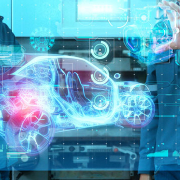Securing the Vehicle Manufacturing Process: Safeguarding Vehicles from External Threats
In today’s rapidly evolving automotive technology, vehicles have transcended their traditional mechanical realm and embraced the innovations of the digital age. These advancements have ushered in convenience and comfort for drivers, but they have also introduced the challenge of cybersecurity. External threats, such as espionage and virus infiltration, can jeopardize the safety of vehicles. Therefore, it is imperative that robust software monitoring is integrated into the vehicle manufacturing process to shield them from external risks.

Development of Internet of Vehicles (IoV) and Information Security Issues
In the contemporary manufacturing of automobiles, vehicle control systems heavily rely on complex software. These software components encompass a wide array of functionalities, including engine control, network connectivity, entertainment systems, safety assistance, and autonomous driving. However, these very functionalities make them vulnerable to hacking attacks. Hackers may exploit vulnerabilities or introduce viruses into the vehicle system, endangering not only the vehicle’s security but also potentially stealing sensitive driver information.
To counter these cybersecurity threats, vehicle manufacturers and relevant tech companies must handle security risks prudently during the design and development of vehicle control systems. Foremost, manufacturers should adhere to best practices in software development to ensure the security of software code. This involves utilizing reliable development tools, conducting rigorous code reviews, and conducting regular security testing.
Secondary to this, vehicle control systems should enforce strict restrictions on external access. Only authorized personnel should be permitted to perform necessary configuration and maintenance tasks, with access subject to proper identity authentication and authorization controls. Moreover, for network-connected components, manufacturers should employ robust encryption technologies to ensure data security during transmission.
Safety Measures During The Vehicle Lifecycle
Furthermore, cybersecurity protection should be an ongoing concern throughout the entire lifespan of the vehicle. This means that regular software monitoring and updates must be conducted during the vehicle’s usage. Through these updates, manufacturers can promptly patch potential security vulnerabilities and enhance the vehicle’s cybersecurity defense capabilities.
Beyond the implementation of cybersecurity measures during development, vehicle manufacturers should establish comprehensive vulnerability tracking and emergency response mechanisms. In the event of identifying security vulnerabilities, vehicle owners should be promptly notified, and appropriate remediation solutions should be provided. Additionally, manufacturers should proactively address potential cybersecurity incidents, responding swiftly to minimize potential damages.
Security Measures for Automobile Manufacturers
During the manufacturing process, safeguarding vehicles from external threats through robust cybersecurity measures is of paramount importance. Vehicle manufacturers should implement stringent security measures during the development phase, regularly monitor and update software, and establish emergency response mechanisms. By remaining vigilant and taking appropriate protective measures, the safe evolution of automotive technology can provide drivers with a worry-free driving experience in the future.





